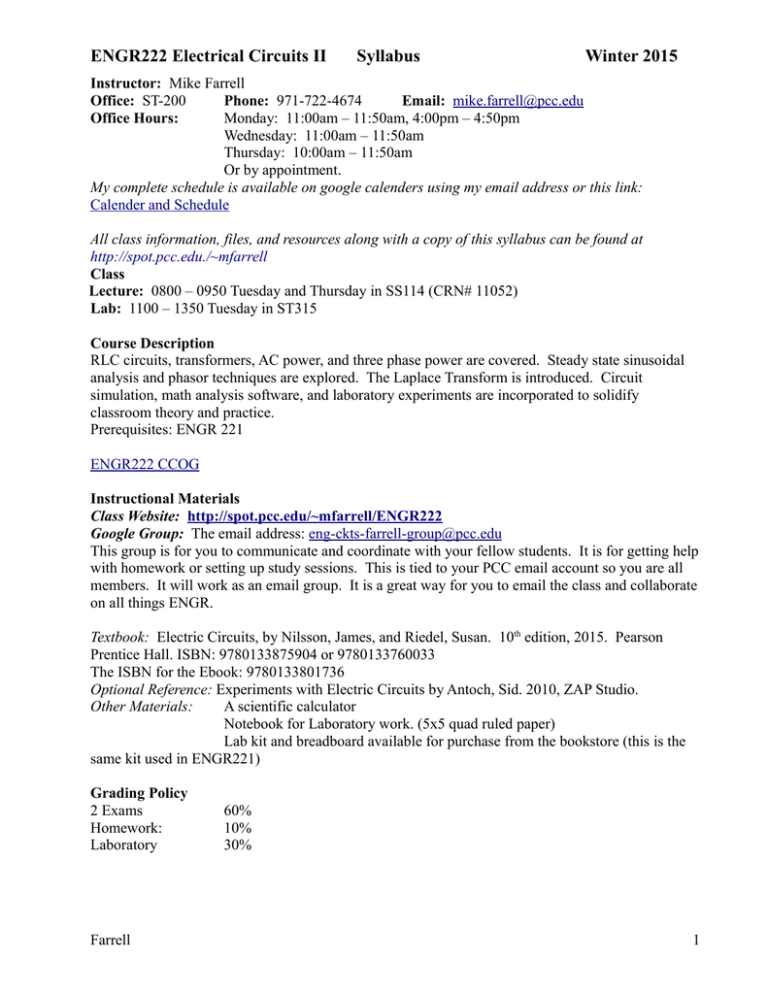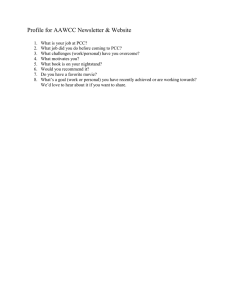
ENGR222 Electrical Circuits II
Syllabus
Winter 2015
Instructor: Mike Farrell
Office: ST-200
Phone: 971-722-4674
Email: mike.farrell@pcc.edu
Office Hours:
Monday: 11:00am – 11:50am, 4:00pm – 4:50pm
Wednesday: 11:00am – 11:50am
Thursday: 10:00am – 11:50am
Or by appointment.
My complete schedule is available on google calenders using my email address or this link:
Calender and Schedule
All class information, files, and resources along with a copy of this syllabus can be found at
http://spot.pcc.edu./~mfarrell
Class
Lecture: 0800 – 0950 Tuesday and Thursday in SS114 (CRN# 11052)
Lab: 1100 – 1350 Tuesday in ST315
Course Description
RLC circuits, transformers, AC power, and three phase power are covered. Steady state sinusoidal
analysis and phasor techniques are explored. The Laplace Transform is introduced. Circuit
simulation, math analysis software, and laboratory experiments are incorporated to solidify
classroom theory and practice.
Prerequisites: ENGR 221
ENGR222 CCOG
Instructional Materials
Class Website: http://spot.pcc.edu/~mfarrell/ENGR222
Google Group: The email address: eng-ckts-farrell-group@pcc.edu
This group is for you to communicate and coordinate with your fellow students. It is for getting help
with homework or setting up study sessions. This is tied to your PCC email account so you are all
members. It will work as an email group. It is a great way for you to email the class and collaborate
on all things ENGR.
Textbook: Electric Circuits, by Nilsson, James, and Riedel, Susan. 10th edition, 2015. Pearson
Prentice Hall. ISBN: 9780133875904 or 9780133760033
The ISBN for the Ebook: 9780133801736
Optional Reference: Experiments with Electric Circuits by Antoch, Sid. 2010, ZAP Studio.
Other Materials:
A scientific calculator
Notebook for Laboratory work. (5x5 quad ruled paper)
Lab kit and breadboard available for purchase from the bookstore (this is the
same kit used in ENGR221)
Grading Policy
2 Exams
Homework:
Laboratory
Farrell
60%
10%
30%
1
ENGR222 Electrical Circuits II
Syllabus
Laboratory Grade:
Experiment demonstration, Notebook and Participation:
Lab Report #1:
Lab Report #2:
Winter 2015
50%
10%
40%
Final grade is based on your final percentage.
90-100% =A, 80-89% = B, 70-79%=C 60-69% = D, and <60% = F
Significant Figures:
You are expected to give all answers to three significant figures. You will lose points on homework
and tests if you do not do this. I expect all answers in decimals not fractions.
Class Organization:
Approximately half of the class time a week will be dedicated to working examples and homework
problems, the other half will be spent lecturing and explaining topics. I am not able to lecture on the
entire topic in just 2 hours. You are expected to read the text. The lectures will be focused on
providing more depth or an alternative view to help with comprehension of the text.
Tentatively the first hour of any lecture day will be spent on answering questions from the previous
days assignment. On Thursday this should be going into more depth or answering questions on the
reading. On Tuesdays, this will involve answering HW questions.
You should plan to have the required sections read by Thursday class and your homework done by
Tuesday class. This system will make it very hard to put off all work in this class until the weekend.
Your goal should be to find some time each day to dedicate to this class.
Homework
Homework is intended for a chance to practice the concepts presented in class. Your homework will
be graded on completeness, not on correctness. You should approach the homework as a practice
test. If you do well on it than you have grasped the concepts. If you struggle with the homework
assignment or don't finish it, then you need more practice on that concept. Homework assignments
represent the minimum amount of practice required. If you have a hard time with the homework
problems, work examples, assessment problems or other problems in the text. Once you have
worked the easier problems return to the homework problem and attempt it again.
Your homework grade is not based on how many problems you get right or wrong, but simply
whether or not you attempt the problems. Your grade will be based on completeness.
Completeness includes finishing the problem and communicating your solution and process to
the reader. Homework problems may be marked incorrect or correct to provide you with
feedback. If a problem is marked correct than it is 100% correct. Any problem not marked as
correct should be reworked until you understand it. If you don't understand you should get
help. Answers will be posted for you to review and check your work.
Farrell
2
ENGR222 Electrical Circuits II
Syllabus
Winter 2015
Homework Format and requirements
• All HW on 8.5”x11” paper
• Paper should not have torn edges
• Name and HW assignment number on top right of first page
• Multiple pages stapled in order
• One homework assignment per stapled bunch
• Should be neat and legible
• All problems require easily recognizable Given, Find, and Solution sections
• All problems start on their own page
• Answers given with 3 significant figures
• Put a box around final answers
Full credit can only be earned if this format is followed.
Late homework will not be accepted.
Homework answers are posted prior to the assignment being due. You should be able to check
your work and ask questions about where you get stuck.
If you have homework questions you want to ask during class. Come into class earlier and draw the
problem with your work, up to where you get stuck. This will save us time in getting me up to speed
to answer your question. You may also get your answer from a classmate.
Homework Sections
Each homework problem should have a Given, Find, and Solution section. This is a pretty standard
format that you may have used in other classes.
• Given
◦ Contains the important details given in the problem definition
◦ Most likely includes a schematic, though it may not. For design problems the schematic
is likely the solution
◦ It is NOT a rewrite of the problem definition
◦ List pertinent facts or values that will be needed to solve the problem
• Find
◦ What question are you solving?
◦ What are you looking for?
◦ Whatever you box/circle as your final answer should be an answer to this question
• Solution
◦ This is where you show your work
◦ Show all the steps that you must take to get from the Given to the Final Answer
◦ Just showing the final answer will not get you credit
◦ When you use your calculator to solve a problem, show the equations that you entered
into the calculator.
◦ Your work should flow in an organized manner and be easy to follow
◦ Box your final answer, so I know what you think the final answer is
• Plan
◦ This is an optional section. It is located before the Solution section or at the top of the
solution section
◦ We will use this section when we work examples or homework problems in class
◦ This is your plan for how you will solve the problem. It is a list of the steps that must be
Farrell
3
ENGR222 Electrical Circuits II
Syllabus
Winter 2015
taken
◦ These steps are listed qualitatively without numbers. You don't actually solve any
problems here
◦ For example for a balance of power problem the steps might look like
▪ Apply passive sign convention
▪ Find power for each element
▪ Sum all powers and look for a net result of 0
Laboratory:
You are expected to work in two person teams in the lab, during the term.
The laboratory experiments are going to be a little different this term. There are only two lab
projects this term.
These will be multi-week experiments. You will be expected to develop experimental procedure,
design and test circuits, calculate expected results, and verify proper operation. The instructions for
these projects are somewhat vague. You will be expected to decide exactly how to take a
measurement. You lab instructor is available for help but not to give you the answer.
Once you have completed a project you are expected to write a formal report on this project. You
may work on this report with your team but each member needs to turn in their own report.
The due dates for these reports are listed below. If you finish them before these dates you may turn
them in then. Late reports will not be accepted without prior approval.
The specifications for these projects can be found on the spot website for this class.. You will also
find guidelines for keeping a lab notebook, for writing the formal report, and the grading rubric.
Taking the time to review all of these documents before you start any project will reduce confusion
and make things easier.
Laboratory Schedule (this schedule is subject to change)
Lab Project #1 from Handout Formal Report Due: 2/10/14 @1700 (Week 6)
Lab Project #2 from Handout Formal Report Due: 3/13/14 @1700 (Week 10)
Tentative Schedule (this schedule is subject to change)
Ch8-12 and Ch13 sections 1 & 2.
The final is comprehensive and is scheduled for Thursday, March 19.
Farrell
4
ENGR222 Electrical Circuits II
Syllabus
Winter 2015
Class Rules
Respect others and act with courtesy.
Resources for Student Success
Counseling
Disability Services
Roots
Student Learning Center
Tutoring
Veterans Resource Center
Form study groups, get to together, work together... communicate.
Students may attend this course only if registered. Students who are unable to attend must drop the course on
line or through the Registration Office. To have tuition charges removed, the course must be dropped by the
student before the drop deadline posted on MyPCC and in the Class Schedule. Students who never attend, or
stop attending, without dropping may receive a W or a failing grade and will be required to pay for the course.
http://www.pcc.edu/registration/dropping.html
If you have a disability and need an accommodation, please make arrangements to meet with me outside of
class. PCC students requesting accommodations must provide documentation of disability and work with The
Office for Students with Disabilities (OSD) at 503-977-4341 Disability Services
Official Grade and Code of Conduct links
Grading Guidelines
Student Rights and Responsibilities
If you are caught cheating you may fail the entire course.
The course content and requirements may be adjusted in response to institutional, weather or class situations
as needed, with adequate notice to students.
Farrell
5


